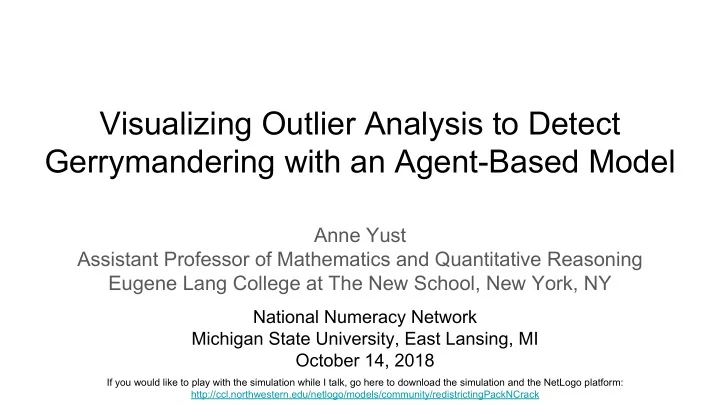

Visualizing Outlier Analysis to Detect Gerrymandering with an Agent-Based Model Anne Yust Assistant Professor of Mathematics and Quantitative Reasoning Eugene Lang College at The New School, New York, NY National Numeracy Network Michigan State University, East Lansing, MI October 14, 2018 If you would like to play with the simulation while I talk, go here to download the simulation and the NetLogo platform: http://ccl.northwestern.edu/netlogo/models/community/redistrictingPackNCrack
Introduction to Partisan Gerrymandering Definition -- Drawing district lines in order to benefit a particular political party ● First noted instance: political cartoon displaying a particularly funky-looking district proposed by the Massachusetts legislature in 1812 ● Current governor was Elbridge Gerry (actually pronounced more like Gary) ● Mashup of Gerry and salamander ● Often crazy shapes indicate manipulation of district outcomes Why do we let this happen??! If you would like to play with the simulation while I talk, go here to download the simulation and the NetLogo platform: http://ccl.northwestern.edu/netlogo/models/community/redistrictingPackNCrack
Introduction to (Re)Districting Why don’t we stop gerrymandering from happening?? ● State Legislature proposes and passes (possibly with governor veto power) ● Some states have adopted an independent commission process to create maps (Michigan(!), Colorado, Utah on ballot in 2018) Why do we create districts at all?? ● It’s the law! (for the US House of Reps) ● Geographic representation is useful ○ for electorates to have point-person ○ for elected rep to understand concerns of geographic community If you would like to play with the simulation while I talk, go here to download the simulation and the NetLogo platform: http://ccl.northwestern.edu/netlogo/models/community/redistrictingPackNCrack
How do we create districts? ● Top (legislated-ish) priorities for creating district maps ○ Equal population (approximately)* *Only federally mandated ○ Compactness (no crazy shapes) constraints (all others may ○ Contiguity (connected, no holes) or may not be in individual state constitutions). ○ Compliance with the Voting Rights Act (race)* ○ Respect for county/city boundaries (political geography) ○ Respect for “communities of interest” (sociology) What else might we want from our district maps to promote fair representation? (What would seem fair or not fair ??) ○ Proportionality (ideologically, racially) ○ Competition (close races)
How to Gerrymander Packing & Cracking with Two Parties: the Stars Party and the No-Stars Party Packing the No-Stars Green Plan Red Plan Cracking the Proportional No-Stars representation There are 21 Stars and 21 No-Stars in the two copies of the “state” shown above. If you would like to play with the simulation while I talk, go here to download the simulation and the NetLogo platform: http://ccl.northwestern.edu/netlogo/models/community/redistrictingPackNCrack
Quantitative methods used ● Compactness ○ Found in most State Constitutions ■ “As compact as possible” ○ Crazy-looking shapes aren’t enough to show gerrymandering ■ We’ve gotten smarter/more tech savvy! ■ Though, a crazy shape is likely a warning sign (unless it’s due to a natural boundary) ● Efficiency gap ○ Measure of “wasted votes” ○ Used in the Wisconsin SCOTUS case (Gill v Whitford) ● Outlier Analysis ○ Measure of likelihood of proposed map election outcomes ○ (Variant) Used successfully in PA Supreme Court case (LWV v PA General Assembly) If you would like to play with the simulation while I talk, go here to download the simulation and the NetLogo platform: http://ccl.northwestern.edu/netlogo/models/community/redistrictingPackNCrack
Outlier Analysis If a million monkeys made a million district maps (following all the rules, of course), how many maps would result in the same predicted election outcome? Basic idea of statistical inference ● “Innocent until proven guilty” (or innocent until there’s enough evidence to suggest that there’s a statistically significant difference in our result) ● If no one intentionally meddled with the map to influence the result, our monkey-maps sample would contain many maps with the same result. ● If there weren’t any monkey-generated maps (or very few), we’d suspect that the map was created with an agenda to swing the district election outcomes If you would like to play with the simulation while I talk, go here to download the simulation and the NetLogo platform: http://ccl.northwestern.edu/netlogo/models/community/redistrictingPackNCrack
My Model ● Simulates random district maps ○ Not using the exact methods that the theory is based on ○ Warning: the maps must be sampled from a uniform distribution of all possible maps (MCMC, graph theory) -- my simulation is certainly not doing that ● Builds histogram of predicted election outcomes of each district map ● Creates gerrymandered district map using packing and cracking algorithms ● Gives proportion of times gerrymandered map was created If you would like to play with the simulation while I talk, go here to download the simulation and the NetLogo platform: http://ccl.northwestern.edu/netlogo/models/community/redistrictingPackNCrack
Model of Population Distribution If you would like to play with the simulation while I talk, go here to download the simulation and the NetLogo platform: http://ccl.northwestern.edu/netlogo/models/community/redistrictingPackNCrack
Histogram of Election Outcomes If you would like to play with the simulation while I talk, go here to download the simulation and the NetLogo platform: http://ccl.northwestern.edu/netlogo/models/community/redistrictingPackNCrack
Generated Maps without and with Packing n’ Cracking If you would like to play with the simulation while I talk, go here to download the simulation and the NetLogo platform: http://ccl.northwestern.edu/netlogo/models/community/redistrictingPackNCrack
Plans for assessment and improvement ● Assessment of Student Learning ○ Implement in courses ■ (ULEC) Fair Representation: Gerrymandering and the Political Process ■ (First-Year Seminar) The Simulation Games: Death, Disease, Denial, and Drugs ■ Quantitative Reasoning ○ Assess understanding of concepts relating to ■ Fairness ■ Gerrymandering ■ Outlier analysis ■ Likelihood ● Model Improvements ○ Add button for gerrymandering for Democrats ○ Fix code - really inefficient ● Get published in Numeracy :) If you would like to play with the simulation while I talk, go here to download the simulation and the NetLogo platform: http://ccl.northwestern.edu/netlogo/models/community/redistrictingPackNCrack
Thank you! If you would like to play with the simulation while I talk, go here to download the simulation and the NetLogo platform: http://ccl.northwestern.edu/netlogo/models/community/redistrictingPackNCrack
Recommend
More recommend